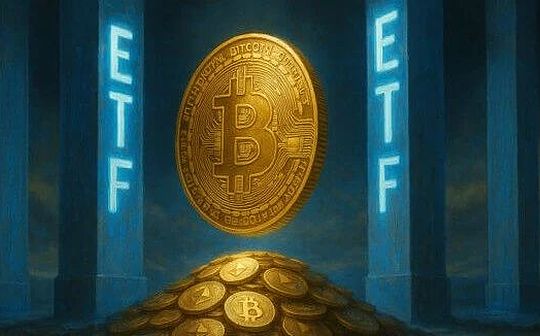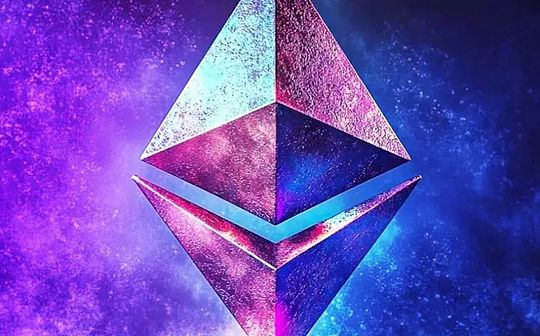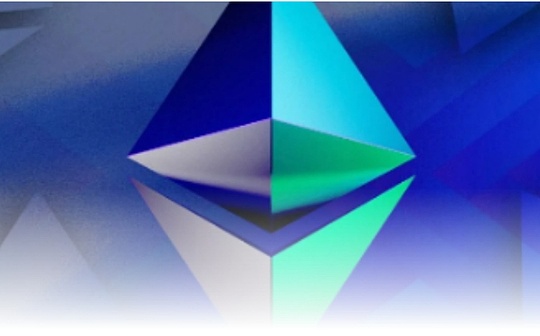
Author: Xinwei, MT Capital
TL;DR
-
The necessity of parallel EVM is that it solves the efficiency problem of traditional EVM processing transactions in sequence, and significantly improves the network throughput and performance by allowing multiple operations to be executed simultaneously.
-
The implementation methods of parallel EVM include scheduling-based concurrent processing, multi-threaded EVM instances, system-level sharding, and also face technical challenges such as unreliable timestamps, blockchain determinism, and validator profit orientation.
-
Monad Labs aims to significantly improve blockchain scalability and transaction speed through its Layer 1 project Monad, with unique technical features, including processing up to 10,000 transactions per second, block time of 1 second, parallel execution capability and MonadBFT consensusmechanism.
-
Sei V2 is an important upgrade to the Sei network, aiming to be the first fully parallelized EVM, providing backward compatible EVM smart contracts, optimistic parallelization, new SeiDB data structures and interoperability with existing chains, aiming to be largelyImprove transaction processing speed and network scalability.
-
Neon EVM is a platform on Solana designed to provide an efficient, secure, and decentralized environment for Ethereum dApps, allowing developers to easily deploy and run dApps while taking advantage of Solana’s high throughput and low cost.
-
Lumio is a Layer 2 solution developed by Pontem Network. It innovatively solves Ethereum’s scalability challenges by uniquely supporting the Move VM used by EVM and Aptos, bringing the Web3 experience to a close to Web2 level.
-
Eclipse is an Ethereum Layer 2 solution that uses SVM to accelerate transaction processing and adopts a modular rollup architecture that integrates Ethereum settlement, SVM smart contracts, Celestia data availability and RISC Zero fraud proof.
-
Solana uses its Sealevel technology to achieve parallel smart contract processing, Sui improves throughput through Narwhal and Bullshark components, Fuel implements parallel transaction execution through UTXO model, and Aptos uses Block-STM engine to improve transaction processing capabilities, both of which show the blockchain field.Different implementations and advantages of parallel technology in the process.
-
The main challenges of adopting parallelism include addressing data competition and read-write conflict issues, ensuring technology compatibility with existing standards, adapting to new ecosystem interaction patterns, and managing increased system complexity, especially in terms of security and resource allocation.
-
Parallel EVM demonstrates great potential in enhancing blockchain scalability and efficiency, marking a major transformation in blockchain technology, improving transaction processing capabilities through multiple processors simultaneously executing transactions, breaking through the traditional sequential transaction processinglimit.While parallel EVMs offer great potential, their successful implementation requires overcoming complex technical challenges and ensuring widespread ecosystem adoption.
The basic concept of parallel EVM
Introduction to EVM
The Ethereum Virtual Machine (EVM) is the core component of the Ethereum blockchain and acts as its computing engine.It is a quasi-Turing-complete machine that provides an operating environment for smart contract execution on the Ethereum network, which is crucial to maintaining trust and consistency throughout the Ethereum ecosystem.
EVM executes smart contracts by processing bytecode, which is a more basic form of compiling smart contract code that is usually written in high-level programming languages such as Solidity.These bytecodes consist of a series of opcodes that perform various functions, including arithmetic operations and data storage/retrieval.EVM runs as a stack machine and processes operations in the future in a first-out manner. Each operation in the EVM has a related gas cost.This gas system measures the computational effort required to perform operations, ensures fair resource allocation and prevents network abuse.
In Ethereum, transactions play an important role in the functionality of EVM.There are two types of transactions: one is a transaction that causes message calls, and the other is a transaction that causes contract creation.Contract creation results in the creation of a new contract account containing the compiled smart contract bytecode, which is executed when another account makes a message call to the contract.
The architecture of EVM includes components such as bytecode, stack, memory and storage.It has a dedicated memory space for temporarily storing data during execution, and a persistent storage space on the blockchain for indefinitely saving data.The EVM is designed to ensure a secure execution environment for smart contracts, isolate them to prevent reentry attacks, and adopt various security measures such as gas and stack depth limits.
In addition, EVM’s influence goes beyond Ethereum and extends to a wider range through the EVM compatibility chain.Although different, these chains maintain compatibility with Ethereum-based applications, allowing them to interact seamlessly with Ethereum basic applications.These chains play a key role in various fields such as enterprise solutions, GameFi and DeFi.
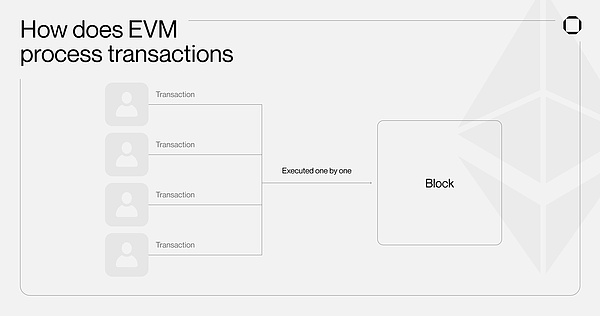
Necessity of parallel EVM
The necessity of parallel EVM (Ethereum Virtual Machine) is due to its ability to significantly improve the performance and efficiency of blockchain networks.Traditional EVMs process transactions in sequence, which not only consumes a lot of energy, but also has a lot of work on network validators.This approach often leads to high transaction costs and inefficiency and is considered the main obstacle to widespread adoption of blockchains.
Parallel EVM revolutionizes the consensus process by allowing multiple operations to be performed simultaneously.The ability to execute in parallel greatly improves the throughput of the network, thereby enhancing the performance and scalability of the entire blockchain.Using parallel EVM, blockchain networks can process more transactions in a shorter time, effectively solving common congestion problems and slow processing time in traditional blockchain systems.
Parallel EVM has a significant impact on all aspects of blockchain technology:
-
It provides a more energy-efficient transaction processing method.By reducing the workload of validators and the entire network, parallel EVM helps build a more sustainable blockchain ecosystem.
-
Increased scalability and increased throughput directly lead to lower transaction fees.Users will enjoy a more economical experience, making the blockchain platform more attractive to a wider audience.
-
Processing multiple transactions simultaneously rather than in sequence means that dApps can run smoother even during high network demand.
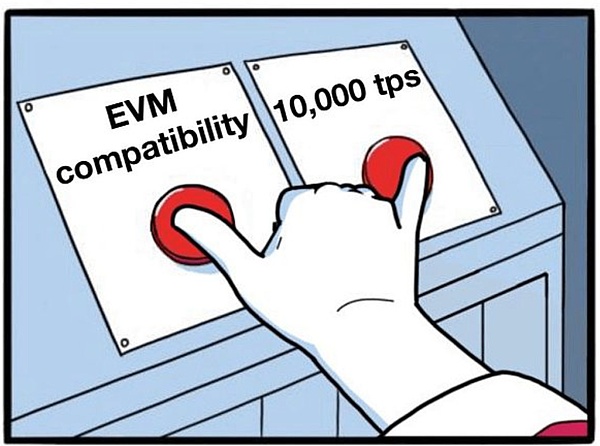
Implementation method of parallel EVM (cited from Siyuan.H)
In the current EVM architecture, the most finest read and write operations are sload and store, which are used to read and write data from state tries, respectively.Therefore, ensuring that different threads do not conflict on these two operations is a simple entry point to implementing parallel/concurrent EVM.In fact, there is a special type of transaction in Ethereum, including a special structure called “access list” that allows transactions carrying storage addresses to be read and modified.Therefore, this provides a good starting point for implementing a scheduling-based concurrency method.
In terms of system implementation, there are three common parallel/concurrent EVM forms:
-
Multithreading of an EVM instance.
-
Multithreading of multiple EVM instances on a node.
-
Multithreading (basically system-level sharding) of multiple EVM instances on multiple nodes.
Parallel/concurrency differs from database systems in blockchains in the following ways:
-
Unreliable timestamps make timestamp-based concurrency methods difficult to deploy in the blockchain world.
-
Absolute certainty on the blockchain system to ensure that the re-execution transactions between different validators are the same.
-
The ultimate goal of validators is to have higher returns, rather than execute transactions faster.
So what do we need?
-
System-level consensus is required, and faster execution will bring higher returns.
-
Multivariate scheduling algorithms that take into account block limitations can capture more revenue while being able to complete execution faster.
-
More fine-grained data operations, including opcode-level data locking, memory cache layer, etc.
Main projects and their technologies
Monad Labs
Monad is EVM Layer 1, aiming to significantly improve the scalability and transaction speed of blockchain through its unique technical features.The key advantage of Monad is that it can handle up to 10,000 transactions per second and has a block time of 1 second.This is thanks to its MonadBFT consensus mechanism and EVM compatibility, which enable it to process transactions efficiently and quickly.
One of Monad’s most striking features is its ability to execute parallel, which allows it to process multiple transactions simultaneously, which greatly improves network efficiency and throughput compared to sequential processing methods in traditional blockchain systems.
Monad’s development was led by Monad Labs and was co-founded by Keone Hon, Eunice Giarta and James Hunsaker.The project has successfully raised $19 million in seed funding and plans to launch a testnet in the mid-1Q2024 and subsequently launch the mainnet.
Monad has been optimized in four major areas to make it a high-performance blockchain:
-
MonadBFT:
MonadBFT is a high-performance consensus mechanism of the Monad blockchain, which is used to achieve consistency in transaction sorting under partial synchronization conditions in the presence of Byzantine actors.It is an improved version based on HotStuff, adopts a two-stage BFT algorithm, is optimistic and responsive, and has linear communication overhead in common cases and secondary communication overhead in timeout cases.In MonadBFT, the leader sends a new block and a previous round of QC (Quorum Certificate) or TC (Timeout Certificate) to the validator each round.The validator reviews the block and, if agreed, sends a signed “yes” vote to the next round of leaders.This process uses threshold signature to aggregate the “yes” votes of **2f+1** validators to form QC.In common cases of communication, the leader sends blocks to the validator, and the validator sends a vote directly to the leader of the next round.MonadBFT also uses paired-based BLS signatures to solve scalability problems, which can aggregate signature increments into one signature, verifying a single valid aggregate signature to prove that all shares associated with the public key have signed the message.For performance considerations, MonadBFT adopts a hybrid signature scheme where BLS signatures are only used for aggregated message types (voting and timeout).The integrity and authenticity of the message are still provided by the ECDSA signature.Due to these characteristics, MonadBFT can achieve efficient and robust blockchain consensus.
-
Delayed execution:
This is a key innovation that decouples the execution process from the consensus process.Under this architecture, the consensus process involves nodes reaching agreement on the official sorting of transactions, while execution is the process of actually executing these transactions and updating the state.In this design, the leader node proposes transaction sorting, but does not know the final state root when the sorting is proposed; when the verification node votes for the validity of the block, it does not know whether all transactions in the block will be executed successfully.
This design allows Monad to achieve significant speed improvements, allowing single-segment blockchains to scale to millions of users.In Monad, each node independently executes transactions in block N while reaching consensus on block N and starts reaching consensus on block N+1.This approach allows for a larger gas budget, as execution only needs to keep up with consensus speed.Furthermore, since execution only requires averaging consensus on average, this approach is more tolerant of specific changes in computing time.
To further ensure state machine replication, Monad includes a Merkle root delayed by D blocks in the block proposal.This delayed Merkle root ensures that even if nodes perform errors or malicious behaviors, the consistency of the entire network can be maintained.
In MonadBFT, the final certainty is a single slot (1 second), and the execution result is usually less than 1 second behind the full node.This finality of single slot means that after submitting a transaction, the user will see the official sort of transactions after a single block.Unless the super majority of the network is malicious, there is no possibility of reordering.For users who need to quickly understand the results of the transaction (e.g., high-frequency traders), full nodes can be run to minimize latency.
-
Parallel execution:
It enables Monad to execute multiple transactions simultaneously.This approach seems to be different from Ethereum’s execution semantics for the first time, but it is not.Monad’s blocks are the same as Ethereum’s blocks, and are both linearly sorted transaction sets.The results of executing these transactions are the same between Monad and Ethereum.
During parallel execution, Monad uses an optimistic execution method, i.e., the execution of subsequent transactions before an earlier transaction in the block is completed.This can sometimes lead to incorrect execution results.To solve this problem, Monad by tracking the inputs used during the execution of the transaction and comparing them to the output of the previous transaction.If there is a difference, it means that the transaction needs to be re-executeed with the correct data.
In addition, Monad uses a static code analyzer when executing transactions to predict dependencies between transactions to avoid invalid parallel execution.In the best case, Monad can predict many dependencies in advance; in the worst case, it falls back to a simple execution mode.
Monad’s parallel execution technology not only improves network efficiency and throughput, but also reduces transaction failures caused by parallel execution by optimizing execution strategies.
-
MonadDb:
MonadDb is used for optimization of data storage and processing.It is part of the Monad optimization strategy designed to improve overall network performance, especially in processing state and transactional data.Such components are designed to enhance the efficiency and scalability of data storage and improve the ability of blockchain networks to process large amounts of data.It includes improved data indexing mechanisms, more efficient storage structures and optimized data access paths.These optimizations help reduce data access time, improve transaction processing speed, and thus improve the performance of the entire blockchain network.
Ecological projects
Tayaswap
TayaSwap is a Monad-based AMM DEX powered by SubLabs, which allows trading assets without a traditional order book or intermediary.AMM relies on mathematical formulas and smart contracts to facilitate token exchange, determine prices, and use smart contracts to enable peer-to-peer transactions.
Ambient Finance
Ambient (formerly CrocSwap) is a decentralized transaction protocol that allows the combination of bilateral AMMs with centralized and constant product liquidity on any pair of blockchain assets.Ambient runs the entire DEX in a single smart contract, where a single AMM pool is a lightweight data structure, rather than a separate smart contract.
Shrimp Protocol
Shrimp is a (3,3) DEX with flywheel token economics that supports real-world assets and is about to land on Monad.
Catalyst
Catalyst is a license-free liquidity solution between modular blockchains, built to connect all chains, designed to enable access to any asset anywhere.Catalyst enables developers to automatically connect to all chains, gain access to users in a unified ecosystem, while its simple, decentralized and self-hosted design ensures projects can access liquidity safely and seamlessly.
Swaap
Swaap is a market-neutral automatic market maker (AMM).It combines oracle and dynamic spreads to provide sustainable returns for liquidity providers and offers traders cheaper prices.The protocol greatly reduces impermanent losses and provides a multi-asset pool.
Elixir
Elixir is a decentralized market maker protocol that uses market maker algorithms to interact with trading centralized assets through API calls, bringing liquidity to long-tail crypto assets.
Timeswap
Timeswap is an AMM-based decentralized money market protocol that does not use oracles or liquidators.Unlike Uniswap that can trade assets in real time, borrowing on Timeswap involves trading tokens until repayment is completed.The lender provides asset A for borrowing while “protecting” a certain amount of asset B used by the borrower as collateral.Users can adjust their risk profile to get higher interest rates at lower collateral ratios and vice versa.
Poply
Poply is a community-based NFT marketplace that specializes in Monad chains, displays and empowers NFT collections created specifically for this chain, attracting people interested in unique NFTs through the use of AI to generate artistic and user-friendly interfaces.ERC-721 token trading.
Switchboard
Switchboard is a permissionless, customizable, multi-chain oracle protocol for universal data feeds and verifiable randomness.By allowing anyone to push any form of data, regardless of the data type, it provides users with a one-stop service and helps drive the next generation of decentralized applications.
Python Network
Python Network is Douro Labs’ next-generation price oracle solution developed by Douro Labs to provide valuable financial market data on-chain, including cryptocurrencies, stocks, forex and commodities to projects and protocols, as well as the public through blockchain technology.The network aggregates first-party price data from more than 70 trusted data providers and publishes it for use by smart contracts and other on-chain or off-chain applications.
AIT Protocol
AIT Protocol is an artificial intelligence data infrastructure that provides Web3 artificial intelligence solutions.The AIT decentralized marketplace provides millions of cryptocurrency users with a special and extensive opportunity to participate in the “training is making money” task, a concept that allows them to earn rewards while actively promoting the development of AI models andContribute to development.
Notifi
Notifi provides a common communication layer for all Web3 projects, planning to embed notification and messaging capabilities into decentralized applications to interact with users on digital and on-chain channels.The Notifi API allows developers to unlock complex communication infrastructures through simple APIs that provide native user experience for all applications in the world; Notifi Center provides users with a notification experience with customized information, which will be from both the mobile and the web.Allows users to view and manage all information in the Web3 world; Notifi Push enables marketers to create cohesive multi-channel engagement that drives business growth and retains their user base.
ACryptoS
ACryptoS is an advanced crypto strategy platform, a multi-chain income aggregation optimizer and DEX, providing automatic composite single token vault, dual token LP vault, unique liquidity vault, Balancer-V2 branch DEX and stablecoin exchangeA variety of unique products including.Originally launched on the BNB chain in November 2020, ACryptoS has now expanded to 11 chains with more than 100 vaults deployed to support DeFi users and protocols.
MagmaDAO
MagmaDAO is a liquid staking protocol controlled by DAO, designed to achieve fair token allocation through ecosystem competition airdrops. It is the first distributed validator outside Ethereum, built on the fastest, cheapest, and most censor-resistant capability.Strong EVM L1 on Monad.
Wombat Exchange
Wombat Exchange is a multi-chain stablecoin transaction with an open liquidity pool, low slippage and unilateral staking.
Wormhole
Wormhole is a decentralized universal messaging protocol that enables developers and users of cross-chain applications to take advantage of multiple ecosystems.
DeMask Finance
DeMask Finance is an on-chain AMM protocol used for transactions between NFT and ERC20 tokens.DeMask Finance supports the creation of NFT collections and NFT transmitters: paired with ETH and other tokens.NFT decentralized exchange: Supports ERC-1155 NFT or other tokens to pair with ETH and ERC-20 tokens.The DeMask protocol aims to increase liquidity for the NFT market, providing an interface to enable seamless exchange between ERC20 tokens or native tokens and NFT collections.DeMask is an interconnected smart contract system where all users can create and own liquidity pools and trade in a fully automated way.Each pool will hold a pair of assets, including a token and an NFT, providing a fixed price for instant transactions.This also allows other contracts to estimate the average price of both assets over time.Users with liquidity pools will receive rewards when exchanging asset pairs.
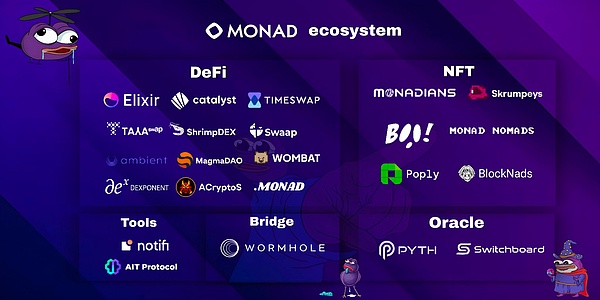
Sei V2
Sei V2 is an important upgrade to the Sei network, and it aims to be the first fully parallelized EVM.This upgrade will give Sei the following features:
-
Backward compatible EVM smart contracts:
This means that developers can deploy audited, EVM-compatible smart contracts on Sei without changing the code.This is extremely important for developers as it simplifies their process of transferring existing smart contracts from other blockchains such as Ethereum to Sei.
From a technical point of view, Sei nodes will automatically import Geth – the Go implementation of Ethereum virtual machine.Geth will be used to process Ethereum transactions, and any resulting updates (including state updates or calls to non-EVM-related contracts) will be made through a special interface created by Sei for the EVM.
-
Optimistic parallelization:
It allows blockchains to support parallelization without the need for developers to define any dependencies.This means that all transactions can run in parallel, and when a conflict occurs (e.g., the transaction touches the same state), the chain will track the storage portion of each transaction touching and rerun the transactions in sequence.This process will continue recursively until all unexplained conflicts are resolved.Because transactions are arranged in an orderly manner in blocks, this process is deterministic and can simplify the developer’s workflow while maintaining chain-level parallelism.
-
SeiDB:
It will introduce a new data structure called SeiDB to optimize the platform’s storage layer.The main goal of SeiDB is to prevent state bloat, i.e., the problem that the network becomes too heavy data, while simplifying the state synchronization process of new nodes.Such a design is designed to improve the overall performance and scalability of the Sei blockchain.
Sei V2 achieves this by transforming the traditional IAVL tree into a dual-component system—state storage and state commitment.This change significantly reduces latency and disk usage, and Sei V2 also plans to switch to PebbleDB to improve read and write performance for multithreaded access.
-
Interoperability with existing chains:
Sei V2 allows a seamless combination between EVM and any other execution environment supported by Sei, providing developers with a smoother experience, where they can easily access local tokens and other chain features such as staking.It will also create a new component to support EVM smart contracts.These EVM smart contracts will benefit from all changes made to consensus and parallelization, and will also be able to interact with existing Cosmwasm smart contracts.
From a performance perspective, Sei V2 will provide throughput of 28,300 batch transactions per second, while providing 390 millisecond block time and 390 millisecond finality.This allows Sei to support more users, provide a better interactive experience than existing blockchains, while providing cheaper per transaction costs.
The main upgrade progress of Sei V2 is now close to the completion of the code.After the review is completed, this upgrade will be released on the public test network in the first quarter of 2024 and will be deployed to the main network in the first half of 2024.
Neon
Neon EVM leverages the capabilities of the Solana blockchain to provide an efficient environment for Ethereum dApps.It runs as a smart contract within Solana, allowing developers to deploy Ethereum dApps with minimal or no code changes and benefit from the advanced features of Solana.Neon EVM’s architecture and operations focus on security, decentralization and sustainability, providing Ethereum developers with an opportunity to seamlessly transition to the Solana environment.It takes advantage of Solana’s low fees and high transaction speeds by enabling transactions to be executed in parallel, providing high throughput and reducing costs.The main components of the Neon EVM ecosystem include:
-
Neon EVM Program:
It is an EVM compiled into Berkeley Packet Filter bytecode, running on Solana.It handles Ethereum-like transactions (Neon transactions) on Solana, following Ethereum rules.Neon EVM is configured through a decentralized multi-signature EVM account, where participants can change the Neon EVM code and set parameters.
The process of processing transactions by Neon EVM involves several key steps.First, users initiate transactions similar to Ethereum (N-tx) through Ethereum-compatible wallets.These transactions are encapsulated into Solana transactions (S-tx) through Neon Proxy and then passed to the Neon EVM program hosted on Solana.The Neon EVM program unblocks transactions, validates user signatures, loads the EVM status (including account data and smart contract code), executes transactions in the Solana BPF (Berkeley Packet Filter) environment, and updates the Solana status to reflect the new Neon EVM status.
-
Neon Proxy: It enables Ethereum dApps to port to Neon with minimal reconfiguration.Neon Proxy packages EVM transactions into Solana transactions and is provided in the form of a containerized solution for ease of use.Operators running Neon Proxy servers facilitate execution of Ethereum-like transactions on Solana, accepting NEON tokens as gas fees and other payments within the Solana ecosystem.
-
Neon DAO:DAO provides custodial services to the Neon Foundation and guides future research and development.It operates as a series of contracts on Solana, providing a governance layer that controls the capabilities of Neon EVM.NEON token holders can participate in DAO activities, including making and voting proposals.
-
NEON Tokens: This practical token has two main functions – paying gas fees and participating in governance through DAO.
-
Integrations and Tools:Neon EVM supports a variety of development and analysis integrations and tools.These include block browsers (such as NeonScan), ERC-20 SPL wrappers for token transfer, NeonPass for transferring ERC-20 tokens between Solana and Neon EVMs, NeonFaucet provides test tokens, and compatibility with EVMs such as MetaMaskWallet compatibility.
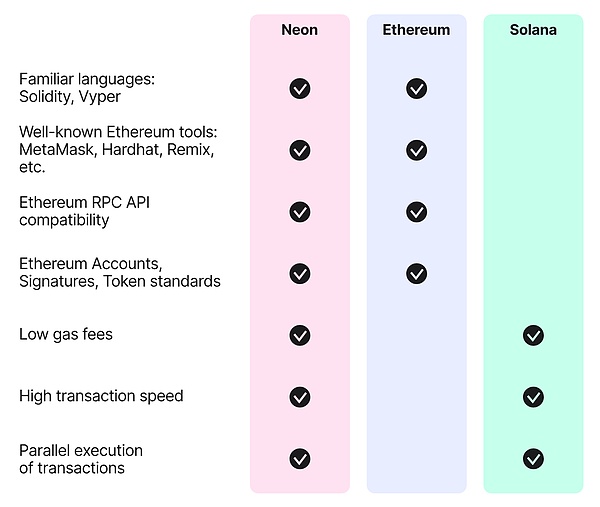
Eclipse
Eclipse is a Layer 2 solution for Ethereum that dramatically accelerates transaction processing by leveraging Solana Virtual Machine (SVM).Eclipse is designed to achieve rapid and scalability, adopts a modular rollup architecture and integrates key technologies such as Ethereum settlement, SVM smart contracts, Celestia data availability, and RISC Zero security.
Specifically, Eclipse Mainnet combines the best modular stack components:
-
Settlement layer –Ethereum: Eclipse uses Ethereum as its settlement layer.At this level, transactions are finalized and secured.Using Ethereum not only means leveraging its sound security and liquidity, but also means using ETH as a gas token that pays transaction fees.Such a setup allows Eclipse to inherit powerful security features from Ethereum.
-
Execution layer –SVM: In terms of smart contract execution, Eclipse adopts SVM.This is in sharp contrast to the way EVM executes transactions sequentially, where SVM can perform parallel transaction processing.The feature of its Sealevel runtime is that transactions that do not involve overlapping states can be processed in parallel, allowing Eclipse to scale horizontally and improve throughput.
-
Data Availability –Celestia: To ensure timely availability and verifiability of data, Eclipse adopts Celestia.Celestia provides a scalable and secure platform for data release and is an important support for Eclipse’s high throughput.
-
Fraud Proof – RISC Zero: Eclipse integrates RISC Zero to perform zero-knowledge fraud proof, avoiding the need for intermediate state serialization, thereby improving the efficiency and security of the system.
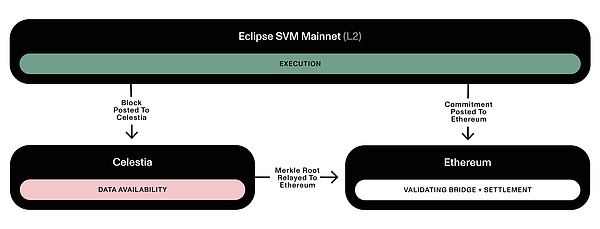
Eclipse is designed to provide Ethereum with a universal Layer 2 solution that can be used at a truly large scale.It aims to address the limitations and resulting isolation and complexity issues caused by rollups in a specific application that can lead to worsening of user and developer experience.Eclipse provides an attractive option for building scalable and high-performance dApps on Ethereum through its modular rollup system and integrated technical components.
Lumio
Lumio is a Layer 2 solution developed by Pontem Network, designed to solve the scalability challenges of Ethereum and bring a Web2-like experience to Web3.It stands out as a unique rollup in the blockchain space because it is able to support both EVM and Aptos’ Move VMs.This dual compatibility allows Lumio to process transactions on Aptos while checking on Ethereum, providing a versatile and efficient solution for dApp developers and users.It has the following key features:
-
Dual virtual machine compatibility:Lumio uniquely supports EVM and Aptos Move VM.This dual compatibility allows Lumio to seamlessly integrate the capabilities of Ethereum and Aptos, increasing the flexibility and efficiency of dApp development and execution.
-
High throughput and low latency: By leveraging high-performance chains like Aptos for transaction sorting, Lumio significantly improves transaction bandwidth.This integration ensures that Lumio can handle large amounts of transactions efficiently while maintaining Ethereum’s security and liquidity characteristics.
-
Optimistic Rollup Technology:Lumio uses an open source OP stack and uses optimistic rollup technology.Optimistic rollups are known for their efficient transaction processing and lower costs, suitable for scaling Ethereum-based applications.
-
Flexible Gas cost economic model:Lumio introduces an application-centric Gas cost economic model.This model allows application developers to benefit directly from network usage and may inspire more innovative and user-friendly dApp development.
-
Interoperability and integration:Lumio is able to process transactions on Aptos and settle on Ethereum, demonstrating a high degree of interoperability between different blockchain ecosystems.This feature allows developers to take advantage of Ethereum and Aptos in their applications.
-
The balance of security and scalability: Combining the powerful security of Ethereum and the scalability of Aptos, it provides developers with an attractive solution to build high-performance, secure dApps.Lumio’s architecture is designed to effectively balance these two key aspects.
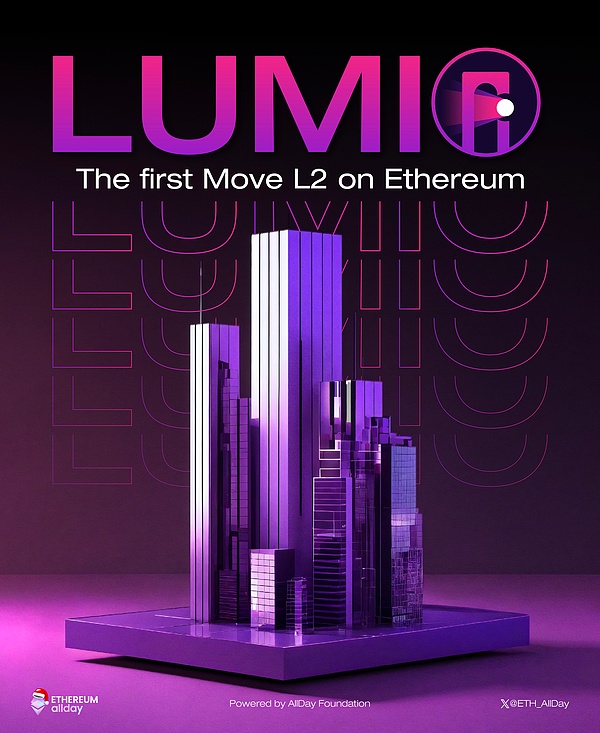
Lumio is currently in closed beta and plans to gradually launch it to selected users.This approach allows for comprehensive testing and improves the platform based on user feedback, ensuring a robust and user-friendly platform for wider releases.
Other parallel projects in the industry
Solana
Solana’s Sealevel technology is a key component of its blockchain architecture, aiming to improve the performance of smart contracts through parallel processing technology.This approach is significantly different from single-threaded processing on other blockchain platforms, such as the WASM-based runtime of EVM and EOS, which process contracts one at a time and modify blockchain state in sequence.
Sealevel enables the Solana runtime to process tens of thousands of contracts in parallel, leveraging all cores available to the validator.This parallel processing capability is possible because Solana transactions explicitly describe all states that will be read or written during execution, allow non-overlapping transactions to be executed concurrently, and only transactions with the same state are read.
Sealevel’s core capabilities are based on Solana’s unique architecture, including components such as Cloudbreak account database and Proof of History (PoH) consensus mechanism.Cloudbreak maps public keys to accounts, account maintenance balances and data, and programs (stateless codes) manage state transitions for these accounts.
Transactions in Solana specify an instruction vector, each instruction contains a program, program instructions, and a list of accounts the transaction wants to read and write.This interface is inspired by the device by the low-level operating system interface, allowing SVM to sort millions of pending transactions and schedule all non-overlapping transactions for parallel processing.In addition, Sealevel can sort all instructions by program ID and run the same program on all accounts at the same time. This process is similar to SIMD (Single Instruction Multi-Data) optimization used in GPUs.
Solana’s Sealevel offers several benefits including enhanced scalability, reduced latency, cost efficiency, and improved security.It enables the Solana network to process substantially higher volumes of transactions per second, providing almost instant final confirmation of transactions, and reducing transaction fees.Even during parallel processing, the security of smart contracts is maintained through Solana’s powerful security protocol.
Sealevel makes Solana a powerful decentralized application platform by enabling high-speed parallel processing and increased transaction throughput.
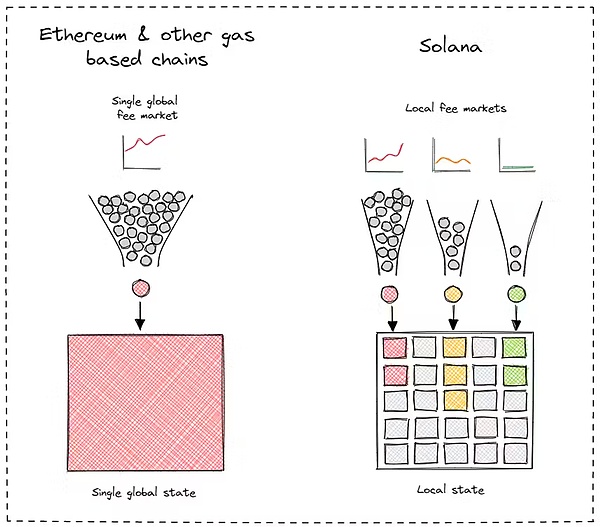
Sui
Sui’s parallel technology features make it a high-efficiency, high-throughput blockchain platform suitable for a variety of Web3 applications and use cases.These significant features work together to improve the efficiency and throughput of their network:
-
Narwhal and Bullshark components: These two components are crucial to Sui’s consensus mechanism.As a memory pool, Narwhal is responsible for accelerating transaction processing, improving network efficiency, and ensuring availability when data is submitted to Bullshark (Consensus Engine).Bullshark is responsible for sorting data provided by Narwhal, leveraging Byzantine fault tolerance to verify the validity of transactions and allocating them across the network.
-
Asset ownership model: In the Sui network, assets can be owned by a single owner or shared by multiple owners.The assets of a single owner can be quickly and freely transferred in the network, while shared assets need to be verified through a consensus system.This asset ownership system not only improves transaction processing efficiency, but also enables developers to create multiple types of assets for their applications.
-
Distributed computing:Sui’s design allows the network to expand resources according to needs, making its functions similar to cloud services.This means that as the demand for Sui network increases, network validators can increase more processing power, maintain network stability, and maintain low gas fees.
-
Sui Move Programming Language:Sui Move is Sui’s native programming language designed to create high-performance, secure, and feature-rich applications.It is based on the Move language and aims to improve the flaws in the smart contract programming language, improve the security of smart contracts and the efficiency of programmers.
-
Programmable Trading Block (PTB): PTB in Sui is a complex, composable transaction sequence that allows access to any public on-chain Move function in all smart contracts.This design provides a strong guarantee for payment or financial-oriented applications.
-
Horizontal scalability:Sui’s scalability is not limited to transaction processing, but also includes storage.This allows developers to define complex assets with rich attributes and store them directly on the chain without having to use indirect off-chain storage to save gas fees.
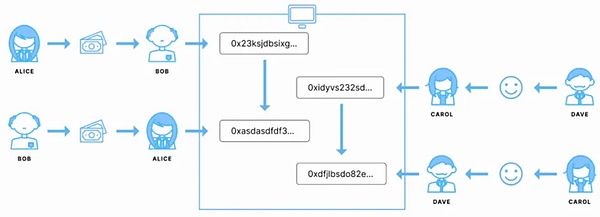
Fuel
In the Fuel network, “parallel transaction execution” is a key technology that enables the network to handle large amounts of transactions efficiently.The core of this parallel execution is achieved by using strict state access lists based on the UTXO (Unspended Transaction Output) model.This model is a fundamental element in Bitcoin and many other cryptocurrencies.
Fuel introduces the ability to execute parallel transactions in the UTXO model.By using strict state access lists, Fuel is able to process transactions in parallel, leveraging more CPU threads and cores that are usually idle in single-threaded blockchains.This way, Fuel can provide more computing power, state access and transaction throughput than single-threaded blockchains.
Fuel solves the concurrency problem in UTXO models.In Fuel, users do not sign the UTXO directly, but sign the contract ID, indicating that they intend to interact with the contract.Therefore, the user does not directly change the state, resulting in UTXO being consumed.Instead, the block producer will be responsible for handling how various transactions in the block affect the overall state, thus affecting the contract UTXO.The consumed contract UTXO creates a new UTXO with the same core characteristics but updates the storage and balance.
In order to realize parallel transaction execution, Fuel developed a specific virtual machine – FuelVM.FuelVM’s design focus is to reduce waste processing in traditional blockchain virtual machine architectures, while providing developers with more potential design space.It combines lessons learned and suggestions for improvements from the Ethereum ecosystem that cannot be implemented on Ethereum due to the need to maintain compatibility with past versions.
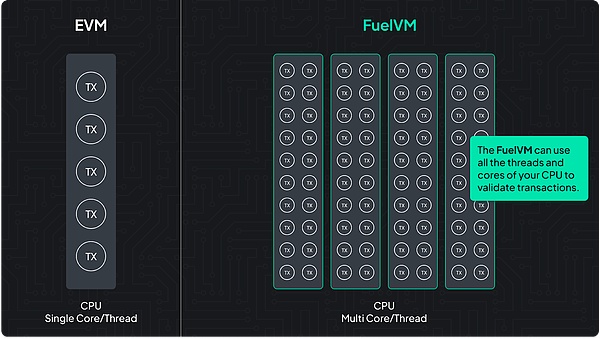
Aptos
The Aptos blockchain adopts a parallel execution engine called Block-STM (Software Transaction Memory) to improve its ability to process transactions.This technique allows Aptos to execute transactions in preset order in each block and assign transactions to different processor threads during execution.The core idea of this method is to record the memory location modified by the transaction while executing all transactions.After all transaction results are verified, if a transaction is found to have access to the memory location modified by the previous transaction, the transaction will be invalidated.The aborted transaction will then be re-execute, and this process will be repeated until all transactions are executed.
Unlike other parallel execution engines, Block-STM maintains the atomicity of transactions without knowing the data to be read/write in advance.This makes it easier for developers to build highly parallel applications.Block-STM supports richer atomicity than other parallel execution environments that usually require splitting operations into multiple transactions (breaking logical atomicity).Block-STM enhances the user experience by reducing latency and increasing cost efficiency.
In addition, Aptos also adopts a consensus mechanism called AptosBFTv4, a production blockchain BFT protocol proven by strict correctness.The protocol optimizes responsiveness, can provide low latency and high throughput, taking advantage of the underlying network.AptosBFTv4 uses a processor-like pipeline design that ensures maximum resource utilization in each step.Therefore, a single node may participate in many aspects of the consensus, from selecting transactions included in the block to executing another set of transactions, writing the output of another set of transactions to storage, and authenticating the output of another set of transactions.This makes throughput limited only by the slowest stages, rather than the sequential combination of all stages.
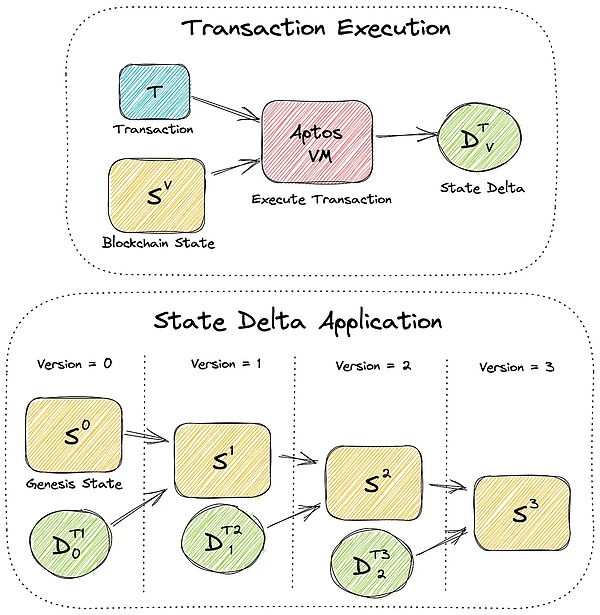
challenge
Technical Problems
Generally speaking, the core challenges of adopting parallel or concurrency approaches are data competition issues, read-write conflicts, or data hazard issues.All of these terms describe the same problem: different threads or operations attempt to read and modify the same data simultaneously.Achieving efficient and reliable parallel systems requires solving complex technical problems, especially in ensuring predictable and conflict-free parallel operations on thousands of decentralized nodes.Additionally, the challenge of technical compatibility is to ensure that new parallel processing methods are compatible with existing EVM standards and smart contract codes.
Ecosystem adaptability
For developers, they may need to learn new tools and methods to maximize the benefits of parallel EVM.In addition, users also need to adapt to the new interaction modes and performance features that may emerge.This requires participants in the entire ecosystem (including developers, users and service providers) to have a certain understanding and adaptability to new technologies.At the same time, a strong blockchain ecosystem relies on not only its technical features, but also on a wide range of developer support and rich applications.To succeed in the market, new technologies such as parallel EVM need to establish sufficient network effects to attract developers and users to participate.
Increased system complexity
Parallel EVM requires efficient network communication to support data synchronization across multiple nodes.Network latency or synchronization failure may lead to inconsistent transaction processing, increasing the complexity of system design.In order to effectively utilize the advantages of parallel processing, the system needs to manage and allocate computing resources more intelligently.This may involve dynamic allocation of load between different nodes, as well as optimizing memory and storage usage.Developing smart contracts and applications that support parallel processing is more complex than traditional sequential execution models.Developers need to consider the features and limitations of parallel execution, which may make the encoding and debugging process more difficult.In a parallel execution environment, security vulnerabilities may be amplified because a security issue may affect multiple parallel execution transactions.Therefore, a more stringent security audit and testing process is needed.
Future Outlook
Parallel EVMs show great potential in improving the scalability and efficiency of blockchains.These parallel EVMs mentioned above represent an important transformation in blockchain technology, aiming to enhance transaction processing capabilities by executing transactions simultaneously on multiple processors.This approach breaks through traditional sequential transaction processing methods, allowing for higher throughput and lower latency, which is crucial for the scalability and efficiency of blockchain networks.
The successful implementation of parallel EVMs depends largely on the vision and skills of developers, especially in the design of smart contracts and data structures.These elements are crucial in determining whether transactions can be executed in parallel.Developers must consider parallel processing from the beginning of the project to ensure that their designs can drive different transactions to run independently without interruption.
Parallel EVM also maintains compatibility with the Ethereum ecosystem, which is crucial for developers and users who are already involved in basic Ethereum applications.This compatibility ensures smooth transition and integration of existing dApps, which is a challenge for systems like having DAGs, as they often require significant modifications to existing applications.
The development of parallel EVMs is seen as a critical step in solving the fundamental limitations of blockchain scalability.These innovations promise to prepare for the future of blockchain networks, allowing them to keep up with growing demand and become the cornerstone of the next generation of Web3 infrastructure.While parallel EVMs offer great potential, their successful implementation requires overcoming complex technical challenges and ensuring widespread ecosystem adoption.
References
https://github.com/hsyodyssey/awesome-parallel-blockchain
https://www.techflowpost.com/article/detail_15290.html
https://amberlabs.substack.com/p/parallel-power-unlocked


